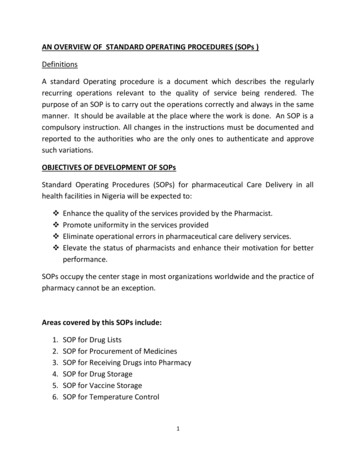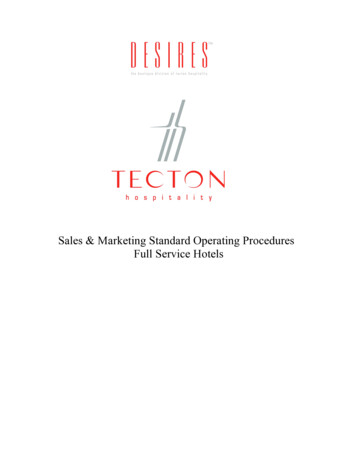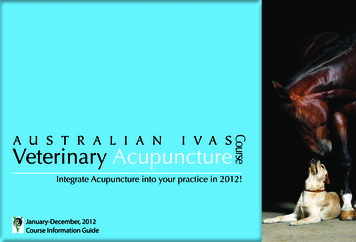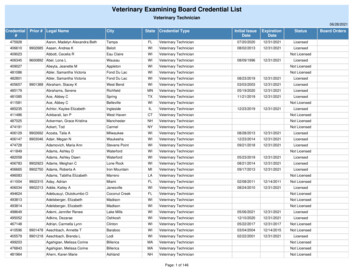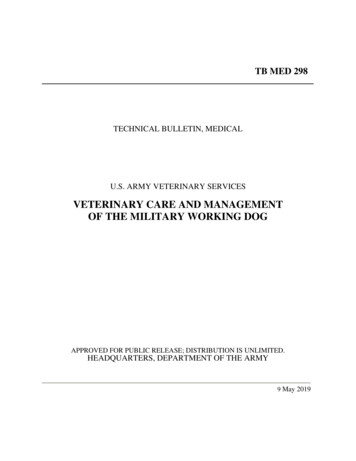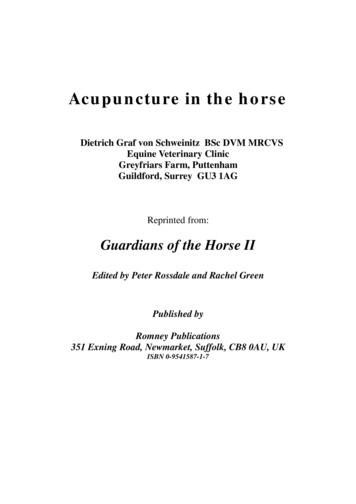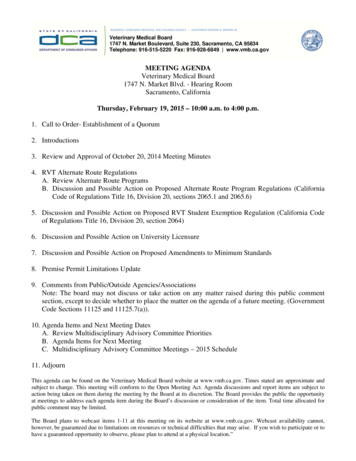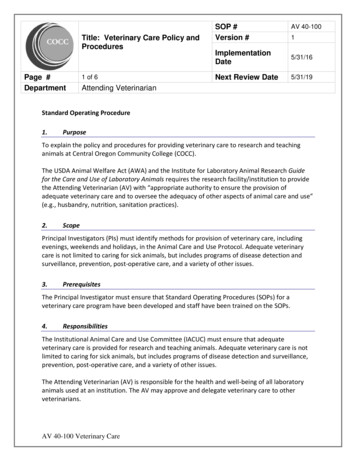
Transcription
Title: Veterinary Care Policy andProceduresPage #Department1 of 6SOP #Version #AV 40-1001ImplementationDate5/31/16Next Review Date5/31/19Attending VeterinarianStandard Operating Procedure1.PurposeTo explain the policy and procedures for providing veterinary care to research and teachinganimals at Central Oregon Community College (COCC).The USDA Animal Welfare Act (AWA) and the Institute for Laboratory Animal Research Guidefor the Care and Use of Laboratory Animals requires the research facility/institution to providethe Attending Veterinarian (AV) with “appropriate authority to ensure the provision ofadequate veterinary care and to oversee the adequacy of other aspects of animal care and use”(e.g., husbandry, nutrition, sanitation practices).2.ScopePrincipal Investigators (PIs) must identify methods for provision of veterinary care, includingevenings, weekends and holidays, in the Animal Care and Use Protocol. Adequate veterinarycare is not limited to caring for sick animals, but includes programs of disease detection andsurveillance, prevention, post-operative care, and a variety of other issues.3.PrerequisitesThe Principal Investigator must ensure that Standard Operating Procedures (SOPs) for aveterinary care program have been developed and staff have been trained on the SOPs.4.ResponsibilitiesThe Institutional Animal Care and Use Committee (IACUC) must ensure that adequateveterinary care is provided for research and teaching animals. Adequate veterinary care is notlimited to caring for sick animals, but includes programs of disease detection and surveillance,prevention, post-operative care, and a variety of other issues.The Attending Veterinarian (AV) is responsible for the health and well-being of all laboratoryanimals used at an institution. The AV may approve and delegate veterinary care to otherveterinarians.AV 40-100 Veterinary Care
Title: Veterinary Care Policy andProceduresPage #Department5.2 of 6SOP #Version #AV 40-1001ImplementationDate5/31/16Next Review Date5/31/19Attending VeterinarianProcedureDelegation of Veterinary Care: The Principal Investigator (PI) submits an Animal Use Protocol (AUP) to the IACUC forapproval. The program for veterinary care is described in the protocol, then reviewedand approved by the AV and IACUC prior to procurement of animals. If an approved protocol designates a veterinarian other than the Attending Veterinarianas the provider of veterinary care for animals in the research/teaching study, thedesignated veterinarian must notify the AV by phone or e-mail of any significant animalconcerns that are the direct result of an animal care and use protocol or if a significantspontaneously occurring herd or colony health problem occurs.Clinical Veterinarian Authority: All clinical veterinarians responsible for the veterinary care of the teaching and researchanimals have the authority to treat any animal that needs immediate care to preservelife or alleviate pain, which may include euthanasia.o Exceptions may include IACUC-approved projects with death as an endpoint orunalleviated pain/distress or other deviations from humane endpoints. The clinical veterinarian or veterinary technician will make a reasonable effort tocontact the investigator or their designee prior to administering analgesics, antibiotics,diagnostics, treatments or euthanasia.o It is important for investigators to promptly respond to all veterinarycommunication. Upon finding a sick or injured animal, husbandry or laboratory staff will notify theappropriate clinical veterinarian specified in the Animal Care and Use Protocol.o The animal will then be assessed by the clinical veterinarian or a veterinarytechnician in consultation with the clinical veterinarian.o The clinical veterinarian or a veterinary technician may euthanize an animalfound to be moribund or in severe pain or distress after attempting to contactthe investigator or their designee.Preventive Medicine Programs: Disease prevention is the cornerstone for maintaining healthy animals and limitingvariables in their environment that may interfere with research. Some of the aspects of an effective preventive medicine program include adequateanimal biosecurity procedures to prevent the introduction of unknown diseases;provisions for quarantine and stabilization; implementation of disease surveillanceAV 40-100 Veterinary Care
Title: Veterinary Care Policy andProceduresPage #Department 3 of 6SOP #Version #AV 40-1001ImplementationDate5/31/16Next Review Date5/31/19Attending Veterinarianprograms including investigations of unexpected deaths; procedures to minimize stressduring handling and restraint; zoonosis prevention; etc.The Principal Investigator must ensure that Standard Operating Procedures (SOPs) for apreventive medicine program have been developed and staff have been trained on theSOPs.Sick, Injured and Dead Animals: It is the responsibility of everyone working with animals at COCC to report any sick orinjured animals to the delegated veterinarian. Reporting must be timely and accurate. Records of the diagnosis, testing, delivery of medical treatments, and final resolutionmust be maintained by the facility or veterinary service. Assurance that compliance with study and humane endpoints is very important andrecurrent or significant problems should be communicated to the IACUC. Unexpected deaths, unexpected or increased mortality must be documented andinvestigated as potential sources of infection or possible research complication. The COCC Attending Veterinarian has the authority to immediately suspend an activitythat causes significant animal welfare or health concerns. The AV will immediately notifythe IACUC of any such situation.Medical Records: Documentation of provision of adequate veterinary care is important from a regulatoryperspective as well as from an animal welfare perspective. Medical records standards are described in “Animal Medical Records” (SOP# AV 20-111).Surgical Procedures and Postsurgical Care: There are many factors that contribute to successful surgical outcomes.o Appropriate training on good surgical technique is crucial. No one is allowed toperform surgery without demonstrating that they are adequately trained toperform the specific techniques they intend to perform.o Pre-surgical planning is necessary to ensure all procedures from before thesurgery starts to the point where animals recover and sutures are removed areperformed at a high level of efficiency to minimize or eliminate pain or distress.o Surgical facilities appropriate for the procedure and the species must be utilized.All surgical facilities must be approved by the IACUC prior to first use andinspected on at least a six month interval thereafter.AV 40-100 Veterinary Care
Title: Veterinary Care Policy andProceduresPage #Department4 of 6SOP #Version #AV 40-1001ImplementationDate5/31/16Next Review Date5/31/19Attending VeterinarianPain and Distress: Recognition, prevention, and alleviation of pain and distress are important and integralresponsibilities for everyone working with animals. Training in the recognition of species-specific signs of pain is essential. One should assume that a procedure that causes pain in humans will also cause pain inanimals. Preemptive analgesics should always be given before a procedure is performed that isexpected to cause more than momentary pain, unless medically contraindicated or ifIACUC exempted based on scientific necessity. If unanticipated pain that is more than momentary is recognized, relief of pain must beinitiated promptly. Consideration for minimizing the duration and intensity of distress must be includedwhen planning the use of animals on a protocol. Humane use of animals dictatesminimizing or eliminating factors that lead to distress.o In addition, stress can cause significant physiological alterations which maynegatively impact research.Euthanasia: Unless an IACUC exemption is given for scientific reasons, the methods for euthanasiafor all species should be consistent with the most current edition of the AVMAGuidelines on Euthanasia. Individuals performing euthanasia must be trained and proficient in the methods ofeuthanasia. Animals that are to be euthanized for experimental purposes must comply withmethods described in the IACUC-approved protocol. Animals euthanized for medical reasons must be euthanized following the AVMArecommendations.6.References1. Institute of Laboratory Animal Resources: Guide for the Care and use of LaboratoryAnimals, National Academy Press, Eighth Edition(http://www.nap.edu/catalog.php?record id 12910).2. Animal Welfare Act and Animal Welfare Regulations. United States Department ofAgriculture, 2013(https://www.aphis.usda.gov/animal 202013%20-%20FINAL.pdf).AV 40-100 Veterinary Care
Title: Veterinary Care Policy andProceduresPage #Department5 of 6SOP #Version #AV 40-1001ImplementationDate5/31/16Next Review Date5/31/19Attending Veterinarian3. National Institutes of Health: Public Health Service Policy on Humane Care and Use ofLaboratory Animals ol.htm).4. The Federation of Animal Science Societies: Guide for the Care and Use of AgriculturalAnimals in Research and Teaching, 3rd Edition, 2010(http://www.fass.org/docs/agguide3rd/Ag Guide 3rd ed.pdf).5. AVMA Guidelines for the Euthanasia of Animals: 2013 /euthanasia.pdf).6. Animal Medical Records (SOP# AV 20-111).7.Definitions1. AV – Attending Veterinarian – responsible for the health and well-being of all laboratoryanimals used at the institution2. AVMA – American Veterinary Medical Association – a not-for-profit organization foradvancing the science and practice of veterinary medicine to improve animal andhuman health3. SOP – Standard Operating Procedure – established or prescribed methods to befollowed routinely for the performance of designated operations or in designatedsituations4. IACUC – Institutional Animal Care and Use Committee – responsible for assessment andoversight of the institution’s animal care program components and facilities5. Chair – Chairperson of the IACUC6. PI – Principal Investigator – a Central Oregon Community College employee having thebackground and training in scientific and administrative oversight necessary to conductand manage the proposed study7. AUP – Animal Care and Use Protocol – protocol created by the principal investigator ofthe proposed research, testing, or educational study8. Protocol – Animal Care and Use Protocol – protocol created by the principal investigatorof the proposed research, testing, or educational study9. COCC – Central Oregon Community College10. Guide – the Guide for the Care and use of Laboratory Animals11. AWA – Animal Welfare Act – requires that minimum standards of care and treatment beprovided for certain animals bred for commercial sale, used in research, transportedcommercially, or exhibited to the public12. PHS – Public Health Service – establishes guidelines for the proper care of animals to beused in research13. Clinical veterinarian – the Attending Veterinarian or designeeAV 40-100 Veterinary Care
Title: Veterinary Care Policy andProceduresPage #DepartmentRevision16 of 6SOP #Version #AV 40-1001ImplementationDate5/31/16Next Review Date5/31/19Attending VeterinarianAuthorCindy ElstonRevisions Made New SOP AV 40-100 Veterinary CareEffective Date5/31/16ApprovalCindy Elston (AV)
8. Protocol - Animal Care and Use Protocol - protocol created by the principal investigator of the proposed research, testing, or educational study 9. COCC - Central Oregon Community College 10. Guide - the Guide for the Care and use of Laboratory Animals 11.
